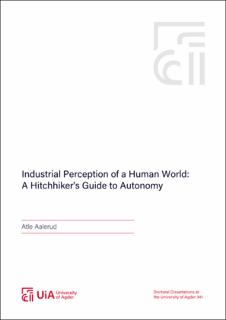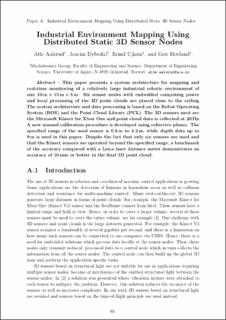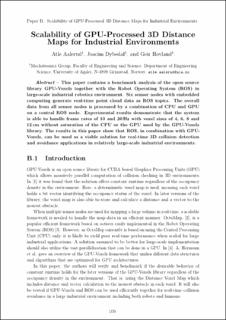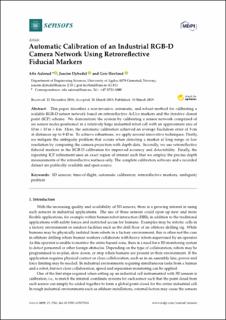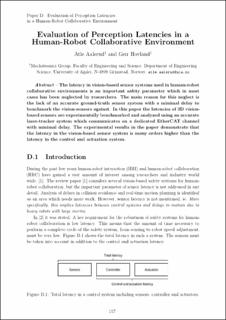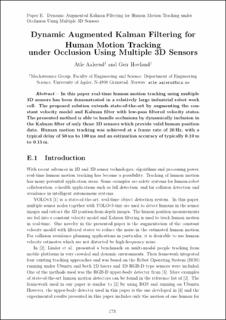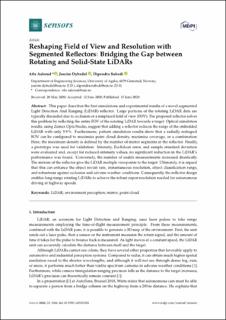| dc.contributor.advisor | Dybedal, Joacim | |
| dc.contributor.advisor | Hovland, Geir | |
| dc.contributor.author | Aalerud, Atle | |
| dc.date.accessioned | 2021-09-26T22:38:11Z | |
| dc.date.available | 2021-09-26T22:38:11Z | |
| dc.date.issued | 2021 | |
| dc.identifier.citation | Aalerud, A. (2021). Industrial Perception of a Human World: A Hitchhiker's Guide to Autonomy [PhD. thesis]. University of Agder. | |
| dc.identifier.isbn | 978-82-8427-047-0 | |
| dc.identifier.issn | 1504-9272 | |
| dc.identifier.uri | https://hdl.handle.net/11250/2783564 | |
| dc.description.abstract | For several decades, industrial automation has helped companies save money and increase workplace safety so that many repetitive and dangerous tasks may be performed in a cost-efficient and secure manner. These systems typically follow a sense-plan-act scheme where sensors provide processed information to select the proper actions. However, without perception, motion control actions are limited to operating in a known static environment without dynamic obstacles. Consequently, the single most significant shortcoming to achieving a higher level of autonomy in cluttered dynamic environments, for instance drilling, crane operations, logistics, and robotics, is to solve scene understanding based on perception. Recent technological advances within artificial intelligence (AI) and the development of new vision sensors have enabled many new perception-based use cases. At the same time, there is a gap between the progress researchers have made and the adoption of these new ideas by various industries. Additionally, the lack of perception knowledge in conservative industries impedes innovation.
This dissertation provides a concise technological guide where the most relevant perception technologies are explained from an industrial perspective. Here, ranging principles and sensor technologies are described. Furthermore, the processes of how to choose perception sensors, combine multiple sensors in a sensor network as well as scale and calibrate the system to monitor a large dynamic environment are outlined. Current methods of processing spatial data are presented where key insights into object detection, segmentation, tracking, prediction, and volumetric data structures are provided. Appended works present the related contributions in light detection and ranging (LiDAR) system development, perception system calibration, mapping, latency evaluation, tracking, and prediction.
It may be concluded that the work presented in this dissertation facilitates increased autonomy for industrial applications. In summary, the where, what, and when of perception have been explained to bridge the gap between research and innovation. This knowledge enables the identification of new perception-based use cases in relevant industries and supports innovation towards autonomous operations. Ultimately, given that the fields of spatial perception and AI are rapidly evolving, this work provides the critical insight required to understand and invest in current and evolving technologies. | en_US |
| dc.language.iso | eng | en_US |
| dc.publisher | University of Agder | en_US |
| dc.relation.ispartofseries | Doctoral Dissertations at the University of Agder; nr. 341 | |
| dc.relation.haspart | Paper I: Aalerud, A., Dybedal, J., Ujkani, E. & Hovland, G. (2018). Industrial Environment Mapping Using Distributed Static 3D Sensor Nodes. In 2018 14th IEEE/ASME International Conference on Mechatronic and Embedded Systems and Applications. IEEE. https://doi.org/10.1109/MESA.2018.8449203. Author´s accepted manuscript. Full-text is available in AURA as a separate file: . | en_US |
| dc.relation.haspart | Paper II: Aalerud, A., Dybedal, J. & Hovland, G. (2018). Scalability of GPU-Processed 3D Distance Maps for Industrial Environments. In 2018 14th IEEE/ASME International Conference on Mechatronic and Embedded Systems and Applications. IEEE. https://doi.org/10.1109/MESA.2018.8449160. Author´s accepted manuscript. Full-text is available in AURA as a separate file: . | en_US |
| dc.relation.haspart | Paper III: Aalerud, A., Dybedal, J. & Hovland, G. (2019). Automatic Calibration of an Industrial RGB-D Camera Network Using Retroreflective Fiducial Markers. Sensors, 19 (7). https://doi.org/10.3390/s19071561. Author´s accepted manuscript. Full-text is available in AURA as a separate file: https://hdl.handle.net/11250/2649291. | en_US |
| dc.relation.haspart | Paper IV: Aalerud, A. & Hovland, G. (2020). Evaluation of Perception Latencies in a Human-Robot Collaborative Environment. IEEE International Conference on Robotics and Automation, 5018-5023. https://doi.org/10.1109/ICRA40945.2020.9197067. Author´s accepted manuscript. Full-text is available in AURA as a separate file: . | en_US |
| dc.relation.haspart | Paper V: Aalerud, A. & Hovland, G. (2020). Dynamic Augmented Kalman Filtering for Human Motion Tracking under Occlusion Using Multiple 3D Sensors. IEEE Conference on Industrial Electronics and Applications, 533-540. https://doi.org/10.1109/ICIEA48937.2020.9248091. Author´s accepted manuscript. Full-text is available in AURA as a separate file: . | en_US |
| dc.relation.haspart | Paper VI: Aalerud, A., Dybedal, J. & Subedi, D. (2020). Reshaping Field of View and Resolution with Segmented Reflectors: Bridging the Gap between Rotating and Solid-State LiDARs. Sensors, 20(12): 3388. https://doi.org/10.3390/s20123388. Author´s accepted manuscript. Full-text is available in AURA as a separate file: https://hdl.handle.net/11250/2735433. | en_US |
| dc.title | Industrial Perception of a Human World : A Hitchhiker's Guide to Autonomy | en_US |
| dc.type | Doctoral thesis | en_US |
| dc.description.version | publishedVersion | en_US |
| dc.rights.holder | © 2021 Atle Aalerud | en_US |
| dc.subject.nsi | VDP::Teknologi: 500 | en_US |
| dc.source.pagenumber | 242 | en_US |
| dc.source.issue | 341 | en_US |
| dc.identifier.cristin | 1938623 | |
